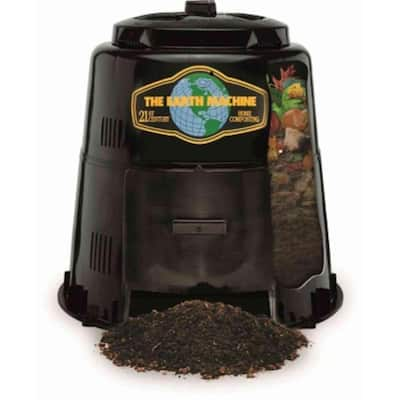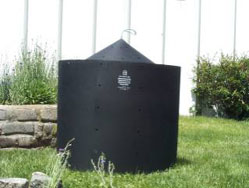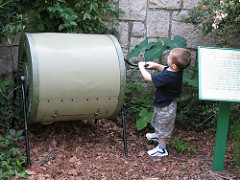It is the most basic of questions: What ‘stuff’ do I need to if I’m going to start composting?
Not surprisingly, the answers are simple and inexpensive. You can compost with a gold-plated compost unit or some pallets tied together, and you can always change things around later.
Here are some basics that I recommend:
1. Kitchen pail

Kitchen pail/bucket/crock. No inside rim makes emptying and cleaning easy. Image courtesy Gardeners.com
You can use something as simple as a yogurt tub on the kitchen counter if you want. I prefer a stainless steel pail for aesthetics, size, durability, light weight, machine wash-ability and one other very important aspect – they have no inside rim. Most kitchen buckets, like the porcelain style ones, have inside rims that catch all the small items like coffee grounds when you try to dump them, and are a pain to clean. The metal pails easily rinse out and can be run through the dishwasher.
They come with lids, but if you are regularly adding scraps, you may prefer to simply put the lid in a cabinet under the sink. If you empty your tub at least once daily, smell should never be an issue.
2. Compost unit
Obviously you need a place to empty the contents of that kitchen pail. There are hundreds of “simple” compost bins you can make with anything from used pallets (heat treated, please) to fallen logs to hardware cloth. There are also units you can buy, ranging in price from $40 to at least $530. Choosing a unit is perhaps the most confusing part for starters, so I’m going to try to simplify it a bit.
Afraid of vermin-Tumbler style: If you live in an urban or semi-urban area and want to compost outdoors (rather than compost with worms in your basement) then get a tumbler style unit. They hold less and are more expensive than other types of compost units; they can be difficult to get the right carbon/nitrogen ratio; maintaining the right moisture level is often difficult; big ones can be cumbersome and difficult to turn, but animals aren’t going to get in them. (If you’ve got limited space or are afraid of vermin, consider vermicomposting instead.)

Best option for most people is the “bottom door” style. Holds a good amount of material, is easy to set up/maintain/empty.
Only compost a little or just starting-Bottom Door style: If you don’t think you’ll make much compost, meaning you don’t have many compostable kitchen scraps or garden trimmings, then a “bottom door” style unit such as the Earth Machine is a good way to go. Put fresh material in at the top, pull finished compost out the bottom. (Every once in a while you should take stuff from the bottom and add to the top just to aerate.) Simple, low-to-moderate in price, limited in size but 2x-3x bigger than tumblers, and very easy to assemble.

New Age Composter/Bin-24 is big, bold, beautiful and what you need if you’re going to compost lots of leaves or anything else.
More compost, more kitchen scraps or more yard waste: Got leaves? Go big. This is when you want to have a large unit(s), whether that means making your own or buying a $40-$50 “New Age Composter“. These will hold more material which is, coincidentally, what is needed (close to 1 cubic yard capacity) to make “hot” compost. If you’re looking to compost leaves you need something this size. They can be a bit difficult to turn or aerate, but there are workarounds. (See “Accoutrements” below.)
3. Second compost unit
This can come later but eventually your first compost bin will get full, at which point your kitchen waste will start to pile up. Use #2 above as a guide to buy/build a second compost unit. If you only need something to hold leaves, the New Age Composter (above) is perfect, or you can build a cheap and easy leaf container from chicken wire or hardware cloth. (Scroll down to “wire-mesh holding unit.”
4. Accoutrements
The things people sell to “help” you compost are limitless. You need very few of them, perhaps none other than a shovel, but here are some items that most will find useful.
– Shovel. Yes indeed, any old shovel will do. Regardless which style composter you buy, you’ll eventually want to shovel that compost from the unit to another place and a shovel is the right tool for the job.
– Aerating tool. This can be the shovel, if you have a “bottom door” style unit. Tumblers don’t need any aeration tool – turning aerates the pile. For those with larger piles I recommend two tools, a pitchfork and a cordless drill.
Specifically, I have become a big fan of using a bulb auger in the drill. This pokes holes deep into the pile, aerating it and mixing contents as well. Please, just make sure your drill is set to the “drive” mode, typically number 1 on most drills, rather than the “drill” mode which spins faster.

One of the most important tools for making fine compost.
– Garden Shears (clippers). If your goal is fine, crumbly compost then clippers are far more important than a compost screen. This is for yard stuff, not most kitchen waste. The best way to get a hot compost pile (which kills diseases and most weed seeds, and finishes faster) is by making sure material is small before adding it. You don’t need to finely dice your tomato stalks in the fall, but chopped up they will decompose faster and hotter because you’ve given bacteria a helping hand. If you have a garden, you probably have a good pair already – use them. (An aside: Do NOT add sticks unless you want to sift them out later.)

Leaf shredder. You can also use a lawn mower.
– Shredder. No, you don’t need to buy a leaf shredder. Chances are good that you already have a lawn mower. That’s fine – extra credit if you install a mulching blade on your mower. I don’t have a power mower, so I do own a leaf shredder that I like, but you can probably ask a neighbor to borrow their mower for a few hours.
5. Do NOT buy
The silly things people sell to help you compost are apparently limitless. Here’s a short list of things you should NOT buy:
- Compost starter
- Lime (as compost starter)
- Self-heating compost units (these use electricity to foment bacteria growth)
- Material to compost
- Machines designed solely to grind up kitchen scraps prior to composting
That’s it, that is all you need to get started. Well, that and some compostable materials. If you think I missed anything, please let me know!




Great post for recycling stuff that you think that it’s not useful anymore. Thanks for your post because now i can reuse some pail in my kitchen.